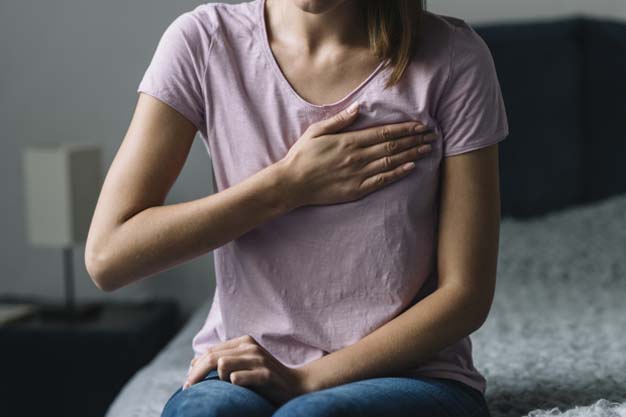The early warning Signs of Breast Cancer
September 2019
Certain changes in the breast may be early signs of breast cancer. Knowing what these changes look and feel like can help people access the right treatment as soon as possible.
Understanding the various parts of the breast and their function can help people be more aware of any changes or abnormalities.
This article looks at the early warning signs of breast cancer, who might be at risk, and what people should do if they spot one or more of these warning signs.
Early signs
When most people think of breast cancer detection, they think of a lump in the breast. This is a possible warning sign, but it is not the only one. It may also not be the first one to develop.
Some other common signs of breast cancer include:
- lumps inside the breast or underarm area
- changes in breast size and shape
- pain in a specific area that does not go away
- prominent veins on the surface of the breast
- nipple discharge that starts suddenly
- a sore or rash on the nipple
- swelling, redness, or darkening of the breast
- dimpling of the skin on the breast
- inversion of the nipple or other parts of the breast
That being said, the same changes are often the result of benign breast conditions. They do not necessarily mean that cancer is present. However, if a person notices these changes, they should see a doctor to make sure.
There are different types of breast cancer, and they can affect individuals in different ways.
Specific signs of inflammatory breast cancer
This is a rare but aggressive type of cancer that can appear differently to other types.
Symptoms include:
- swelling
- redness
- a pink, reddish purple, or bruised appearance
- ridged or pitted skin
- in some cases, a palpable tumor
- a rapid increase in breast size
- heaviness and tenderness in the breast
- a burning sensation
- inversion of the nipple
- swollen lymph nodes in the collarbone or underarm area
Inflammatory breast cancer tends to occur at a younger age than other types of cancer. Doctors sometimes misdiagnose it because it can resemble an infection, trauma, or another problem.
Is it cancer?
The same warning signs that occur with cancer can also signify other benign conditions. It is therefore important to know how to recognize which signs might indicate the presence of cancer and which do not.
Lumps
It is not unusual to have lumpy breasts, as breast tissue is often lumpy in texture. Lumpiness can vary widely and does not always indicate cancer, particularly if it feels the same throughout both breasts.
However, a person should see their doctor if they notice:
- changes in breast texture that are not due to the menstrual cycle
- a harder lump that feels different from the rest of the breast
- a lump that is not present in the other breast
Lumps that are cancerous:
- usually have uneven edges
- are usually painless
- are usually hard
However, the lump can also be soft, rounded, and tender.
People tend to seek medical advice when they are worried about a new lump. However, there may be no lump at all, or the lump may be too small to feel. In fact, a mammogram or other type of screening method may be the first sign of a lump.
If a mammogram reveals a lump, a doctor may suggest further tests — such as an ultrasound or a biopsy — to confirm the diagnosis.
Benign conditions that can involve lumps or lumpiness include:
- cysts
- fibroadenoma
- calcifications
- mastitis
Fibroadenomas consist of glandular and connective tissue. These are very common and not cancerous. Most types do not increase the risk of breast cancer.
Fibroadenomas can be up to an inch in diameter and have a smooth, rubbery feel. They can also move under the skin.
In this article, learn more about fibroadenoma of the breast.
Nipple discharge
Nipple discharge can result from:
- squeezing the nipples
- an infection
A person should see their doctor if they have:
- discharge that occurs without squeezing the nipple
- discharge in one breast and not the other
- discharge that contains blood
Whether or not the discharge relates to cancer, it may need treatment.
Normal breast changes
Hormonal changes can happen at different stages of life, and these can lead to lumps, changes in shape, and other changes that are not due to cancer.
For example, puberty, pregnancy, and menopause may cause changes in the breast because of varying levels of the hormones estrogen and progesterone in the body.
Risk factors
Some people have a higher chance than others of developing breast cancer. If they notice any of the above symptoms, they should be sure to see a doctor.
Factors that increase the risk, according to the American College of Physicians (ACP), include:
- a personal history of breast cancer or a high-risk lesion
- genetic factors, such as the BRCA 1 or BRCA 2 gene mutation
- exposure to chest radiation during childhood
Every case will be different. Knowing about any personal or family history of breast cancer and discussing this with a doctor can help a person know what to look out for.
Also read : 5 Natural Ways to Treat Menopause
About Dr Bedekar Hospital For Women And Children in Thane:
Dr Bedekar Hospital Thane is One of Best Breast Cancer Hospital in Thane.
Do Get in Touch to Book Appointment With Our Experienced Team of Doctors.
Talk to Us On 022 2542 1438 / 9820913256 Or Email Us At bedekarhospital@gmail.com
Happy to Help!
Share This:
Source: www.medicalnewstoday.com



